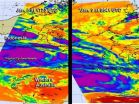Microscopic blood in urine unreliable indicator of urinary tract cancer
Large number of follow-up examinations could be safely avoided say Kaiser Permanente researchers in Mayo Clinic Proceedings
2013-01-10
(Press-News.org) Rochester, MN, January 9, 2013 – Microscopic amounts of blood in urine have been considered a risk factor for urinary tract malignant tumors. However, only a small proportion of patients referred for investigation are subsequently found to have cancer. A new Kaiser Permanente Southern California study published in the February Mayo Clinic Proceedings reports on the development and testing of a Hematuria Risk Index to predict cancer risk. This could potentially lead to significant reductions in the number of unnecessary evaluations.
Individuals with microscopic hematuria (three or more red blood cells per high-power field on a recent urine analysis) are currently referred for follow-up radiologic and invasive examinations, even when they are asymptomatic. American Urological Association (AUA) best practice policy recommendations include urine testing and abdominal computed tomography (CT) or intravenous pyelography plus renal ultrasonography. Patients may also undergo cystoscopy, a procedure that involves passing a narrow tube fitted with a miniature camera into the bladder to closely examine both the bladder and urethra.
In an earlier study, researchers had found that the AUA practice recommendations did not perform well in identifying which patients were most likely to have malignant tumors, suggesting that there might be alternative criteria that better identify patients who truly require further evaluation. Subsequently the team of investigators conducted a prospective cohort study of patients over a two-year period in an integrated care organization in three regions along the West Coast of the United States. They identified both a test cohort and a validation cohort of patients with hematuria evaluations and followed the patients passively through their electronic health records for a diagnosis of urothelial or renal cancer. The degree of microscopic hematuria, history of gross hematuria, smoking history, age, race, imaging findings, and cystoscopy findings were evaluated as risk factors for malignant tumors.
The test cohort consisted of 2630 patients, of whom 55 (2.1%) had a neoplasm detected and 50 (1.9%) had a pathologically confirmed urinary tract cancer. The strongest predictors of cancer were age of 50 years or older and a recent diagnosis of gross hematuria. Male sex was also predictive of cancer, whereas smoking history and 25 or more red blood cells per high-power field on a recent urinalysis were not statistically significant.
The findings were used to create a Hematuria Risk Index to predict cancer risk and performed comparably in the validation cohort of 1784 patients. Overall, 32% of the population was identified as low risk and 0.2% had a cancer detected; 14% of the population was identified as high risk, of whom 11.1% had a cancer found.
"These data confirm that a large number of follow-up examinations could be safely avoided," observes senior investigator Steven J. Jacobsen, MD, PhD, Kaiser Permanente Southern California, Pasadena, California. "They suggest that microscopic hematuria is an unreliable indicator of urinary tract malignant tumors. Patients with microscopic hematuria younger than 50 years and with no history of gross hematuria may not benefit from further evaluation and therefore could avoid unnecessary risk from radiation exposure and invasive endoscopy. These findings may be used to simplify referral guidelines for evaluation in asymptomatic patients with microscopic hematuria and reduce the number of unnecessary evaluations."
INFORMATION: END
ELSE PRESS RELEASES FROM THIS DATE:
2013-01-10
Some retailers, such as Apple's iTunes, are known for using uniform pricing in an effort to simplify consumers' choices and perhaps increase their tendency to make impulse purchases. But other stores, like supermarkets, often have small price differences across product flavors and brands.
As counterintuitive as it might seem, these small price differences may actually make the options seem more similar, according to new research published in Psychological Science, a journal of the Association for Psychological Science. The research shows that adding small differences ...
2013-01-10
COLUMBIA, Mo. –Parenting infants and toddlers can be challenging, and for generations, mothers have turned to other moms for advice. Now, with the availability of the Internet, mothers are consulting each other using modern venues: online message boards. Research from the University of Missouri indicates online discussion boards provide safe environments for mothers to anonymously express child-rearing concerns and receive support from other moms.
"Mothers have feelings that they might be embarrassed to talk about face-to-face with someone," said Jean Ispa, professor ...
2013-01-10
TORONTO, ON – Ecologists at the University of Toronto and the Swiss Federal Institute of Technology Zurich (ETH Zurich) have found that, given time, invading exotic plants will likely eliminate native plants growing in the wild despite recent reports to the contrary.
A study published in Proceedings of the National Academy of Sciences (PNAS) reports that recent statements that invasive plants are not problematic are often based on incomplete information, with insufficient time having passed to observe the full effect of invasions on native biodiversity.
"The impacts ...
2013-01-10
ALBUQUERQUE, N.M. — Sandia National Laboratories Truman Fellow Anne Ruffing has engineered two strains of cyanobacteria to produce free fatty acids, a precursor to liquid fuels, but she has also found that the process cuts the bacteria's production potential.
Micro-algal fuels might be one way to reduce the nation's dependence on foreign energy. Such fuels would be renewable since they are powered by sunlight. They also could reduce carbon dioxide emissions since they use photosynthesis, and they could create jobs in a new industry. President Barack Obama, speaking in ...
2013-01-10
A high-fiber diet may have the clinical potential to control the progression of prostate cancer in patients diagnosed in early stages of the disease.
The rate of prostate cancer occurrence in Asian cultures is similar to the rate in Western cultures, but in the West, prostate cancer tends to progress, whereas in Asian cultures it does not. Why? A University of Colorado Cancer Center study published in the January 2013 issue of the journal Cancer Prevention Research shows that the answer may be a high-fiber diet.
The study compared mice fed with of inositol hexaphosphate ...
2013-01-10
Research by University of Arizona astronomy professor Rodger Thompson finds that a popular alternative to Albert Einstein's theory for the acceleration of the expansion of the universe does not fit newly obtained data on a fundamental constant, the proton to electron mass ratio.
Thompson's findings, reported Jan. 9 at the American Astronomical Society meeting in Long Beach, Calif., impact our understanding of the universe and point to a new direction for the further study of its accelerating expansion.
To explain the acceleration of the expansion of the universe, astrophysicists ...
2013-01-10
Infrared and near-infrared NASA satellite imagery provided signs to forecasters that Tropical Cyclone Narelle is intensifying as it moves southwest paralleling Western Australia coastline. Warnings have been posted as Narelle nears.
The Australian Bureau of Meteorology (ABM) issued the following watch and warnings for Narelle on Jan. 9: A cyclone watch is in effect for coastal areas from Whim Creek to Coral Bay. A Blue alert is in effect for coastal and island communities from Whim Creek to Mardie, including Wickham, Roebourne, Point Sampson, Karratha and Dampier.
The ...
2013-01-10
UNIVERSITY PARK, Pa. -- Living in a caring community may help curb teenage alcohol use, while hanging out with antisocial peers can have the opposite effect, according to Penn State researchers studying substance abuse patterns.
The researchers evaluated how seven different categories of risk and protective factors predicted teen alcohol use. Risk factors included antisocial attitudes, antisocial behaviors, association with antisocial peers and family risk. Protective factors were positive community experiences, positive school experiences and family strengths.
Damon ...
2013-01-10
UNIVERSITY PARK, Pa. -- Mussels can be a mouthwatering meal, but the chemistry that lets mussels stick to underwater surfaces may also provide a highly adhesive wound closure and more effective healing from surgery.
In recent decades bioahesives, tissue sealants and hemostatic agents became the favored products to control bleeding and promote tissue healing after surgery. However, many of them have side effects or other problems, including an inability to perform well on wet tissue.
"To solve this medical problem, we looked at nature," said Jian Yang, associate professor ...
2013-01-10
WASHINGTON - Adapting to future climate change impacts requires capabilities in hydroclimate monitoring, short-term prediction and application of such information to support contemporary water management decisions. These needs were identified in a report, "Short-Term Water Management Decisions: User Needs for Improved Climate, Weather, and Hydrologic Information," published by the Bureau of Reclamation and the U.S. Army Corps of Engineers with the National Oceanic and Atmospheric Administration. It is available online at: http://bit.ly/TJpWxK.
The report identifies how ...
LAST 30 PRESS RELEASES:
[Press-News.org] Microscopic blood in urine unreliable indicator of urinary tract cancer
Large number of follow-up examinations could be safely avoided say Kaiser Permanente researchers in Mayo Clinic Proceedings



